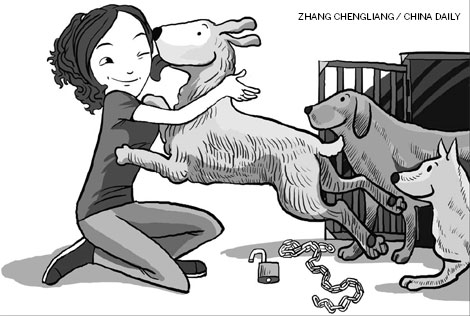Voices
Official proposal argues big dogs have big hearts
By Linda Gibson (China Daily)
Updated: 2010-07-08 09:18
 |
Large Medium Small |

Beijing officials recently unleashed a proposal to lift the ban on big dogs in the city.
It's unscientific, they said, to assume that size has anything to do with how dangerous a dog might be. This idea raised howls of protest among people who fear big dogs, but experts in canine behavior say they're right.
By sniffing around the Internet, it's possible to dig up lots of useful information about dog bites and the victims of dog attacks. The most horrific example of a dog attack was the fatal mauling of a six-week-old infant in 2000 by the family pet - a Pomeranian. The average weight of Pomeranians is about four pounds.
Some of the gentlest, friendliest, most popular dogs among families with children weigh at least 50 pounds, and include Labrador retrievers and Golden retrievers.
There are also many examples of big dogs, including some belonging to feared breeds like pit bulls and Rottweilers, who performed miraculous feats of heroism to save children or adults from danger. Here are a few:
A two-year-old Rottweiler named Reona heard screams after the first jolt of an earthquake in California in 1989. She bolted out of the house, jumped three fences and barged into the home of five-year-old Vivian Cooper, who was standing terrified in the kitchen. Reona shoved the girl against some kitchen cabinets and held her there, right before a big microwave oven came crashing down from the top of the refrigerator to the spot where Vivian had been standing.
Blue, an Australian Blue Heeler, sparred with an alligator attempting to reach his owner, 85-year-old Ruth Gay, after she fell down behind her home in Australia in 2001. The gator finally gave up and lumbered away, allowing Gay and Blue to escape unharmed.

Jarod, a black Chow Chow, fought off a bear in Canada in 2008 that first attacked a dog chained in the backyard and then turned on their owner, Donna Perrault, when she rushed from the house to drive the bear away. Biting the bear repeatedly, Jarod got the animal's attention and lured him away from the yard, then ran back home to safety. All survived the attack.
Each of these dogs, judged on size alone, might have looked dangerous to some. But identifying dangerous dogs proves to be as tricky as spotting dangerous humans. Convenient as it would be to just lock away people who are likely to be dangerous, it isn't possible to pick them out until after they've hurt someone. It's the same with dogs.
There have been cases where even friendly, gentle dogs such as Labrador retrievers and Golden retrievers have bitten someone.
A study of dog bites in the US and Canada showed that boys between the ages of five and nine were most likely to be the victims; that 61 percent of attacks happened at home or in a place familiar to the dog; and that 77 percent of the dogs bit someone who belonged to their own family, or a friend of the family.
Strangers have nothing to fear from a dog passing by in a park or on the sidewalk. Only those who provoke a dog or invade its home territory uninvited are at risk.
Anyone who has been to European countries has seen even huge dogs peaceably accompanying their owners almost everywhere, even to cafes and markets. Here in Beijing, the small dogs most people own already exhibit good manners in public, mostly ignoring strangers and approaching someone only if invited in a friendly way.
So fear not, Beijingers. Big dogs, kindly treated, are no threat to anyone. As long as the members of their human families know how to behave, nobody will get bitten.